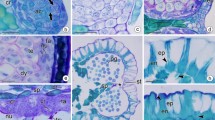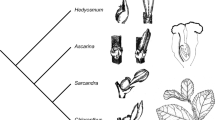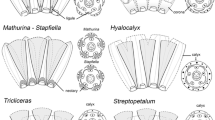Abstract
The majority of monocotyledons are crassinucellate, including some early-branching taxa (sensu Chase et al., 1995a, 1995b) such asTofieldia, although Araceae are predominantly tenuinucellate. The tenuinucellate condition occurs in a taxonomically wide range of monocotyledons, and there is some congruence between this character and existing monocot topologies at higher levels. For example, present evidence indicates a few tenuinucellate asparagoid clades, including Alliaceae sensu stricto and Hypoxidaceae, possibly two tenuinucellate lilioid lineages, and at least two tenuinucellate commelinoid lineages.
Proximal nucellar structures arise from a multi-layered region of the ovule and include hypostase, enlarged dermal cells and conducting passage (Zuleitungsbahn), haustoria, postaments, podia, and perisperm. In some cases they may represent the same tissues at different developmental stages; in general the last three are seed structures. For example, a postament may be a resistant conducting passage from which the surrounding dermal cells have degenerated, or alternatively a resistant hypostase, although both are nucellar in origin. Such terminological confusions cause problems in establishing homologies. Several characters relating to the nucellus are outlined.
Similar content being viewed by others
Literature Cited
Alden, J. 1912. A contribution to the life history ofUvularia sessilifolia. Bull. Torrey Bot. Club.39: 439–446.
Arekal, G. D. &C. D. Nagendran. 1975. Embryo sac ofHydrobryopsis sessilis (Podostemonaceae), origin, organization and significance. Bot. Notizbl.128:332–338.
Arnott, H. J. 1962. The seed, germination and seedling ofYucca. Univ. Calif. Pub!. Bot.35: 1–164.
Ashurmetov, O. A. & S. S. Yengalycheva. In press. Anatomy of ovary and ovule structure inAllium crystallinum Vved. (Alliaceae). Bot. Jahrb. Syst.
Asplund, E. 1920. Studien uber die Entwicklungsgeschichte der Bluten einiger Valerianaceen. Konigl. Svenska Vet.-Akad. Handl.61:1–66.
Aulbach-Smith, C. A. &J. M. Herr. 1984. Development of the ovule and female gametophyte inEustachys petraea andE. glauca (Poaceae). Amer. J. Bot.71:427–438.
Batygina, T. B. 1994. Embryology of flowering plants. Terminology and concepts. Vol. 1. Generative organs of flower. World and Family, St. Petersburg.
— &M. S. Yakolev. 1990. Comparative embryology of flowering plants. Vol. 5. Monocotyledons. Nauka, St. Petersburg.
Berg, R. Y. 1962. Contribution to the comparative embryology of the Liliaceae:Scoliopus, Trillium, Paris andMedeola. Oslo University Press, Oslo.
—. 1978. Development of ovule, embryo sac and endosperm inBrodiaea (Liliales). Nordic J. Bot.25: 1–7.
—. 1996. Development of ovule, embryo sac and endosperm inDipterostemon andDichelostemma (Alliaceae) relative to taxonomy. Amer. J. Bot.83: 790–801.
Björnstad, I. N. 1970. Comparative embryology of Asparagoideae-Polygonatae, Liliaceae. Nytt. Mag. Bot.17:169–207.
Boesewinkel, F. D. 1989. Ovule and seed development in Droseraceae. Acta Bot. Neerl.38:295–311.
Bor, J. R. &F. Bouman. 1974. Development of the ovule and integuments inEuphorbia milii andCodiaeum variegatum. Phytomorphology24: 280–296.
— &R. N. Kapil. 1975.Euphorbia geniculata—ovule to seed. Acta Bot. Neerl.24: 257–268.
Bouman, F. 1984. The ovule. Pages 123–153in B. M. John (ed.), Embryology of angiosperms. Springer-Verlag, Berlin.
Brown, R. C. &H. L. Mogensen. 1972. Late ovule and early embryo development inQuercus gambelii. Amer. J. Bot.59:311–316.
Browne, E.T. 1961. Morphological studiesin Aletris. I. Development of the ovule, megaspores and megagametophyte ofAletris aurea and their connection with the systematics of the genus. Amer. J. Bot.48: 143–147.
Buell, M. F. 1938. Embryogeny ofAcorus calamus. Bot. Gaz.99: 556–568.
Campbell, D. H. 1900. Studies on the Araceae. Ann. Bot.14:1–25.
—. 1905. Studies on the Araceae III. Ann. Bot. 19:329–349.
Capeletti, C. 1927. Processi degenerativi negli ovuli in seuito ad empedita fecondazione. Nuovo Giom. Bot. Ital., n.s.34:409–490.
Cave, M. S. 1941. Megasporogenesis and embryo sac development inCalochortus. Amer. J. Bot.28: 390–394.
—. 1952. Sporogenesis and gametogenesis inOdontostomum hartwegii Torr. Phytomorph.2: 210–214.
—. 1955. Sporogenesis and the female gametophyte ofPhormium tenax. Phytomorph.5:247–253.
—. 1966. The female gametophytes ofLapageria rosea andPhilesia magellanica. Gayana15: 25–31.
—. 1967. The megagametophyte ofAndrocymbium. Phytomorphology17: 233–239.
—. 1975. Embryological studiesof Stypandra (Liliaceae). Phytomorphology25:95–99.
Chase, M. W. & many others. 1993. Phylogenetics of seed plants: an analysis of nucleotide sequences from the plastid generbcL. Ann. Missouri Bot. Gard.80: 528–580.
—,M. R. Duvall, H. G. Hills, J. G. Conran, A. V. Cox, L. E. Eguiarte, J. Hartwell, M. F. Fay, L. R. Caddick, K. M. Cameron &S. Hoot. 1995a. Molecular systematics of Lilianae. Pages 109–137in P. J. Rudall, P. J. Cribb, D. F. Cutler & C. J. Humphries (eds.), Monocotyledons: systematics and evolution. Royal Botanic Gardens, Kew.
—,D. W. Stevenson, P. Wilkin &P. Rudall. 1995b. Monocot systematics: a combined analysis. Pages 685–730in P. J. Rudall, P. J. Cribb, D. F. Cutler & C. J. Humphries (eds.), Monocotyledons: systematics and evolutioa. Royal Botanic Gardens, Kew.
—,P. J. Rudall &J. G. Conran. 1996. New circumscriptions and a new family of asparagoid lilies: genera formerly included inAnthericaceae. Kew Bulletin51: 667–680.
Cheah, C. H. &B. C. Stone. 1975. Embryo sac and microsporangium development inPandanus (Pandanaceae). Phytomorphology25:228–238.
Coe, G. E. 1954. Distribution of carbon in ovules ofZephyranthes drummondii. Bot. Gaz.115:342–346.
Dahlgren, K. V. O.1927. Die Morphologie des Nuzellus mit besonderer Berucksichtigung der deckzellosen Typen. Jahrb. Wiss. Bot.67: 347–426.
—. 1939. Endosperm und Embryobildung beiZostera marina. Bot. Notizbl.1939: 607–615.
—. 1940. Postamentbildung in den Embryosäcken der Angiospermen. Bot. Notizbl.1940:347–369
Dahlgren, R. M. T. 1975. The distribution of characters within an angiosperm system. I. Some embryological characters. Bot. Notizbl.128:181–197.
— &H. T. Clifford. 1982. The monocotyledons—a comparative study. Academic Press, London.
— &A. M. Lu. 1985.Campynemanthe (Campynemaceae): morphology, microsporogenesis, early ovule ontogeny and relationships. Nordic J. Bot.5: 321–330.
——. &P. F. Yeo. 1985. The families of the monocotyledons. Berlin: Springer-Verlag.
Davis, G. L. 1966. Systematic embryology of the angiosperms. John Wiley, New York.
De Vos, M. P. 1949. The development of the ovule and the seed in the Hypoxideae. II. The generaPauridia Harv. andForbesia Ecklon. J. S. Afr. Bot.15: 13–22.
—. 1950. Die ontwikkeling van die saadknop en saad byCyanella capensis L: “n geval van polyembryonie. S. Afr. J. Sci.46:220–226.
Dutt, B. M. S. 1970. Comparative embryology of angiosperms: Haemodoraceae, Cyanastraceae, Amaryllidaceae, Hypoxidaceae, Velloziaceae. Bull. Indian Natn. Sci. Acad.41: 358–374.
Endress, P. K. 1987. The Chloranthaceae: reproductive structures and phylogenetic position. Bot. Jahrb. Syst.109: 153–226.
—. 1990. Evolution of reproductive structures and functions in primitive angiosperms (Magnoliidae). Mem. New York Bot. Gard.55: 5–34.
—. 1994. Floral structure and evolution of primitive angiosperms: recent advances. Pl. Syst. Evol.192: 79–97.
Engler, A. 1901. Beitrage zur Flora von Afrika XX: Berichte über die botanischen Ergebnisse der Nyassa-Secund Kinga-Gebirgs-Exped.,Cyanastraceae. Bot. Jahrb.28: 357.
Eunus, A. M. 1950. Contributions to the embryology of the Liliaceae. I. Development of the embryo sac and endosperm ofAlbuca transvalensis Moss-Verdoom. J. Indian. Bot. Soc.29: 68–78.
—. 1951. Contributions to the embryology of the Liliaceae. V. Life history ofAmaianthium muscaetoxicum Walt. Phytomorphology1: 73–79.
Fagerlind, F. 1940. Stempelbau und Embryosackentwicklung bei einigen Pandanazeen. Ann. Jard. Bot. Buitenzorg49: 55–78.
Fay, M. &M. W. Chase. 1996. Resurrection of Themidaceae for theBrodiaea alliance, and recircumscription of Alliaceae, Amaryllidaceae and Agapanthoideae. Taxon45:441–451.
Fries, T. C. E. 1919. Der Samenbau beiCyanastrum. Svensk. Bot. Tidskr. 13:295–304.
Gäumann, E. 1919. Studien über die Entwicklungsgeschichter eineger Saxifragales. Rec. D. Trav. Bot. Néerl.16:285–322.
Goldblatt, P. 1986. Systematics and relationships of the bigeneric Pacific family Campynemataceae (Liliales). Bull. Mus. Natl. Hist. Nat, Paris, ser. 4, 8, B, Adansonia 117–132.
Graven, P., C. G. De Koster, J. J. Boon &F. Bouman. 1996. Structure and macromolecular composition of the seed coat of the Musaceae. Ann. Bot.77:105–122.
Grayum, M. H. 1991. Systematic embryology of the Araceae. Bot. Rev.57:167–203.
Grootjen, C. J. 1983a. Development of ovule and seed in Marantaceae. Acta Bot. Neerl. 32:69–86.
—. 1983b. Development of ovule and seed inCartonema spicatum R.Br. (Cartonemataceae). Austral. J. Bot.31:297–305.
— &F. Bouman. 1988. Seed structure in Cannaceae: taxonomic and ecological implications. Ann. Bot.61:363–371.
Grove, A. R. 1941. Morphological study ofAgave lechuguilla. Bot. Gaz.103: 354–365.
Haberlandt, G. 1923. Zur embryologie vonAllium odorum. Ber. Deutsch. Bot. Gesell.41:174–179.
Haeckel, I. 1930. Uber Iridaceen. Flora125:1–82.
Hamann, U. 1964. Embryologie und Systematik am Beispiel der Farinosae. Ber. Deutsch. Bot. Ges.77: 45–54.
—. 1966. Embryologische, morphologisch—anatomische und systematische Untersuchungen an Philydraceen. Willdenowia 4: 1–178.
—. 1975. Neue Untersuchungen zur Embryologie und Systematik der Centrolepidaceae. Bot. Jahrb. Syst.96:154–191.
—. 1976. Hydatellaceae—a new family of Monocotyledoneae. New Zealand J. Bot.14:193–196.
Haque, A. 1951. The embryo sac ofErythronium americamm. Bot. Gaz.112: 495–500.
Herr, J. M. 1995. The origin of the ovule. Amer. J. Bot.82: 547–564.
Horner, H. T. &H. J. Arnott. 1966. Histochemical and ultrastructural study of pre-and postgerminatedYucca seeds. Bot. Gaz.127:48–64.
Huss, H. A. 1906. Beitr ge zur Morphologie und Physiologie der Antopoden. Beih. Bot. Zbl.20:77–174.
Jobansen, D. A. 1928. The hypostase: its presence in the ovule of Onagraceae. Proc. Natl. Acad. Sci. U.S.A.14: 710–713.
Kellogg, E. A. &H. P. Linder. 1995. Phylogeny of Poales. Pages 511–542in P. J. Rudall, P. J. Cribb, D. F. Cutler & C. J. Humphries (eds.), Monocotyledons: systematics and evolution. Royal Botanic Gardens, Kew.
Kenton, A. &P. Rudall. 1987. An unusual case of complex-heterozygosity inGelasine azurea (Iridaceae), and its implications for reproductive biology. Evolutionary Trends in Plants1:95–103.
Kuo, J., H. Iizumi, B. E. Nilsen &K. Aioi. 1990. Fruit anatomy, seed germination and seedling development in the Japanese seagrassPhyllospadix (Zosteraceae). Aquatic Bot.37:229–245.
Linder, H. P. &E. A. Kellogg. 1995. Phylogenetic patterns in the commelinid clade. Pages 473–496in P. J. Rudall, P. J. Cribb, D. F. Cutler & C. J. Humphries (eds.), Monocotyledons: systematics and evolution. Royal Botanic Gardens, Kew.
— &P. Rudall. 1993. The megagametophyte inAnarthria and its relatives: systematic implications. Amer. J. Bot.80:1455–1464.
Lu, A. M. 1985. Embryology and probable relationships ofEriospermum (Eriospermaceae). Nordic J. Bot.5: 229–240.
Maheshwari, P. 1950. An introduction to the embryology of angiosperms. McGraw-Hill, New York.
Makde, K. H. 1981. Hypostase in Cyperaccae. Curr. Sci.50:421–422.
Masand, P. &R. N. Kapil. 1966. Nutrition of the embryo sac and embryo—a morphological approach. Phytomorphology16: 158–175.
Maze, J. &L. R. Bohm. 1973. Comparative embryologyof Stipa elmeri. Canad. J. Bot.51: 235–247.
Menezes, N. L. de. 1976. Megasporogenése, megagametogenése e embriogenése em Velloziaceae. Bol. Bot., Univ. São Paulo4:41–60.
Monteiro-Scanavacca, W. R. &S. C. Mazzoni. 1978. Embryological studies inLeiothrix fluitans (Mart.) Ruhl. (Eriocaulaceae). Revista Bras. Bot.1: 59–64.
Mücke, M. 1908. Uber den Bau und die Entwicklung der Früchte und über die Herkunft vonAcorus calamus L. Bot. Zeit.66: 1–123.
Müller-Doblies, D. 1970. Über die Verwandtschaft vonTypha undSparganium in Inflorescenz-und Blütenbau. Bot. Jahrb. Syst.89:451–562.
Müller-Doblies, U. 1969. Über die Blutenstände und Blüten sowie zur Embryologie vonSparganium. Bot. Jahrb. Syst.89: 359–450.
Nietsch, H. 1941. Zur systematischen Stellung vonCyanastrum. Ost. Bot. Z.90:31–52.
Ogura, H. 1964. On the embryo sac of two species ofTricyrtis. Sci. Rep. Tohoku Univ., ser. 4 (Biol.)30: 219–222.
Oikawa, K. 1961. The embryo sac ofChionographis japonica Maxim. Sci. Rep. Tohoku Univ., ser 4 (Biol.)27:155–158.
Ono, T. 1926. Embryologische Studien anHeloniopsis breviscapa. Sci. Rep. Tohoku Univ., ser. 4,2: 93–104.
—. 1929. Embryologie der Liliaceae, mit besonderer Rucksicht auf die Endospermbildung. I. Melanthioideae und Aletroideae. Sci. Rep. Tohoku Univ., ser. 4,4:381–393.
Palm, B. 1915. Studien uber Konstruktionstypen und Entwicklungswege des Embryosackes der Angiospermen. Ph.D. dissertation, University of Stockholm.
Palser, B. F. 1975. The bases of angiosperm phylogeny: embryology. Ann. Missouri Bot. Gard.62: 621–646.
Pate, J. S. &B. E. S. Gunning. 1972. Transfer cells. Ann. Rev. Pl. Physiol.23:173–196.
Pbilipson, W. R. 1974. Ovular morphology and the major classification of the dicotyledons. Bot. J. Linn. Soc.68: 89–108.
Poole, A. L. 1952. The development of theNothofagus seed. Trans. Roy. Soc. New Zealand80: 207–212.
Robbing, W. W. &H. A. Borthwick. 1925. Development of the seed ofAsparagus officinalis. Bot Gaz.80: 426–438.
Robertson, B. L. 1976. Embryology ofJubaeopsis caffra Becc: 2. Megasporangium, megasporogenesis and megagametogenesis. J. South African Bot.42:173–184.
Rombach, S. 1911. Die entwicklung der Samenknospe bei den Crassulaceen. Rec. Trav. Bot. Néerl.8: 182–200.
Rudall, P. J. 1990. Development of the ovule and megagametophyte inEcdeiocolea. Austral. Syst. Bot.3: 265–274.
—. 1994. The ovule and embryo sac in Xanthorrhoeaceaesensu lato. Flora189:335–351.
— &M. W. Chase. 1996. Systematics of Xanthorrhoeaceaesensu lato: evidence for polyphyly. Telopea6:629–647.
— &L. Clark. 1992. The megagametophyte in Labiatae. Pages 65–84in R. M. Harley & T. R. Reynolds (eds.), Advances in Labiate Science. Royal Botanic Gardens, Kew.
— &H. P. Linder 1988. The megagametophyte and nucellus in Restionaceae and Flagellariaceae. Amer. J. Bot.75:1777–1786.
—,S. J. Owens &A. Y. Kenton. 1984. Embryology and breeding systems inCrocus (Iridaceae), a study in causes of chromosome variation. PL Syst. Evol.148:119–134.
-,E. M. Engleman, L. Hansen & M. W. Chase. In press. Systematics and embryology ofHemiphylacus, Anemarrhena and Asparagaceae. PL Syst. Evol.
-,M. W. Chase, D. F. Cutler & J. Rusby. Submitted. Anatomical and molecular systematics of Asteliaceae and Hypoxidaceae. Bot. J. Linn. Soc.
Schlimbach, H. 1924. Beitrage zur Kenntnis der Samenanlagen und Samen der Amaryllidaceen imit Berucksichtigung des Wassergehaltes der Samen. Flora117:41–54.
Schnarf, K. 1928. Über das Embryosackhaustorium beiAnthericum. Oesterr. Bot. Zeit.77: 287–291.
—. 1971.Capsella embryogenesis: the chalazal proliferating tissue. J. Cell Sci.8:201–227.
Steinecke, H. &U. Hamann. 1989. Embryologisch-systematische Untersuchungen an Haemodoraceen. Bot. Jahrb. Syst.111:247–262.
Stenar, H. 1925. Embryologische Studien I. und II. II. Die Embryologie der Amaryllideen. Pages 79–195. Ph.D. dissertation, Uppsala.
—. 1927. Uber die Entwicklung des siebenkemigen Embryosackes beiGagea lutea Ker. nebst einigen Bemerkungen uber die Reduktions—teilung beiGagea minima Ker. Svensk Bot. Tidskr.21: 344–360.
—. 1928. Zur Embryologie derVeratrum-und Anthericum-Gmppen. Bot. Notizbl.1928:357–378.
—. 1932. Studien uber die Entwicklungsgeschichte vonNothoscordum fragrans Kunth undNothoscordum striatum Kunth. Svensk Bot. Tidskr.26:25–44.
—. 1933. Zur embryologie derAgapanthus-Gruppe. Bot. Notizbl.1933: 520–530.
—. 1952. Notes on the embryology and anatomyof Luzuriaga latifolia Poir. Acta Horti Berg.16: 219–232.
Stevenson, D. W. &H. Loconte. 1995. Cladistic analysis of monocot families. Pages 543–578in P. J. Rudall, P. J. Cribb, D. F. Cutler & C. J. Humphries (eds.), Monocotyledons: systematics and evolution. Royal Botanic Gardens, Kew.
Subramanyam, K. &L. L. Narayana. 1972. Some aspects of the floral morphology and embryology ofFlagellaria indica Linn. Pages 211–217in Y S. Murty, B. M. Johri, H. Y M. Ram & T. M. Varghese (eds.), Advances in plant morphology. Sarita Prakashan, Meerut.
Takaso, T. &F. Bouman. 1986. Ovule and seed ontogeny inGnetum gnemon L. Bot. Mag., Tokyo99: 241–266.
Tieghem, P. van. 1866. Recherches sur la structure des Aroidees. Ann. Sci. Nat., Bot., ser. 5,6:72–210.
—. 1898. Structure de quelques ovules et parti qu’on en peut tirer am liorer la classification. J. Bot. (Paris)12: 197–220.
—. 1901. L’oeuf des plantes consid re comme base de leur classification. Ann. Sci. Nat., Bot., ser. 8,14:213–390.
Tilton, V. R. 1980a. The nucellar epidermis and micropyleof Ornithogalum caudatum (Liliaceae) with a review of these structures in other taxa. Canad. J. Bot.58:1872–1884.
—. 1980b. Hypostase development inOrnithogalum caudatum (Liliaceae) and notes on other types of modifications in the chalaza of angiosperm ovules. Canad. J. Bot.58: 2059–2066.
Varitchak, B. 1940. Le développement du sac embryonaire et le nombre des chromosomes chez la planteNarthecium scardicum Kosanin. Bull. Acad. Sci. Math. Nat. Belgrade6B: 97–105.
Venkateswarlu, J., P. Sarojni Devi &A. Nirmala. 1980. Embryological studies inEleutherine plicata Herb, andBelamcanda chinensis Lern. Proc. Indian Acad. Sci. (P1. Sci.).89: 361–367.
Venturelli, M. &F. Bouman. 1986. Embryology and seed development inMayaca fluviatilis (Mayacaceae). Acta Bot. Neerl.35:497–516.
——. 1988. Development of ovule and seed in Rapateaceae. Bot. J. Linn. Soc.97:267–294.
Westermaier, M. 1890. Zur Embryologie der Phanerogamen, inbesondere uber die sogenannten Antipoden. Nova Acata d. Ksl. Leop. -Carol. Deutschen Akad. d Naturforscher 57.
—. 1897. Zur physiologie und morphologie der Angiospermen-Samenknospe. Beitr. Wiss. Bot.1: 255–280.
Wiegand, K. M. 1900. The development of the embryo-sac in some monocotyledonous plants. Bot. Gaz.30:25–47.
Wilms, H. J. 1980. Development and composition of the spinach ovule. Acta Bot. Neerl.29:243–260.
Young, D. J. &L. Watson. 1970. The classification of dicotyledons: a study of the upper levels of the hierarchy. Austral. J. Bot.18:387–433.
Yu-fen, L. &S. Jia-Heng. 1990. The studies on embryology inFritillaria ussuriensis Maxim. Acad. Bot. Sin.32: 499–504.
Author information
Authors and Affiliations
Rights and permissions
About this article
Cite this article
Rudall, P.J. The Nucellus and Chalaza in monocotyledons: Structure and systematics. Bot. Rev 63, 140–181 (1997). https://doi.org/10.1007/BF02935930
Issue Date:
DOI: https://doi.org/10.1007/BF02935930




